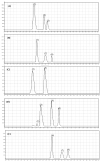Genetic Differentiation in Anthocyanin Content among Berry Fruits
- PMID: 33946926
- PMCID: PMC8929022
- DOI: 10.3390/cimb43010004
Genetic Differentiation in Anthocyanin Content among Berry Fruits
Abstract
Anthocyanins are widely distributed secondary metabolites that play an essential role in skin pigmentation of many plant organs and microorganisms. Anthocyanins have been associated with a wide range of biological and pharmacological properties. They are also effective agents in the prevention and treatment of many chronic diseases. Berries are particularly abundant in these compounds; therefore, their dietary intake has health-promoting effects. The aim of this study was to identify and determine the anthocyanin content in selected species and cultivars of berry fruits, such as raspberry, blackberry, red currant, blackcurrant, and highbush blueberry, widely consumed by Europeans. The concentrations of anthocyanins were determined by HPLC, identifying individual compounds: cyanidin-3-O-glucoside, pelargonidin-3-O-glucoside, delphinidin-3-O-glucoside, delphinidin-3-O-rutinoside, cyanidin-3-O-rutinoside, delphinidin-3-O-galactoside, cyanidin-3-O-galactoside, and malvidin-3-O-galactoside. The experimental data showed that the selected species and cultivars of berry fruits differ significantly in the contents of anthocyanins. Among all species tested, blackberry and blackcurrant were characterized significantly by the highest content of anthocyanins (sum), while the lowest content was found in red currant fruits. Additionally, the content of individual anthocyanin compounds in particular species and cultivars was also different. Considering the high content of anthocyanins and their potential positive impact on human health and protection against disease, berries should be part of healthy nutrition.
Keywords: HPLC method; anthocyanin; berry fruits; bioactive compounds; blackberry; blackcurrant; highbush blueberry; raspberry; red currant.
Conflict of interest statement
The authors declare no conflict of interest. The funders had no role in the design of the study; in the collection, analyses, or interpretation of data; in the writing of the manuscript; or in the decision to publish the results.
Figures




References
-
- García-Gómez B.E., Salazar J.A., Nicolás-Almansa M., Razi M., Rubio M., Ruiz D., Martínez-Gómez P. Molecular Bases of Fruit Quality in Prunus Species: An Integrated Genomic, Transcriptomic, and Metabolic Review with a Breeding Perspective. Int. J. Mol. Sci. 2020;22:333. doi: 10.3390/ijms22010333. - DOI - PMC - PubMed
-
- Mannino G., Gentile C., Ertani A., Serio G., Bertea C. Anthocyanins: Biosynthesis, Distribution, Ecological Role, and Use of Biostimulants to Increase Their Content in Plant Foods—A Review. Agriculture. 2021;11:212. doi: 10.3390/agriculture11030212. - DOI
-
- Krishnan V., Rani R., Pushkar S., Lal S.K., Srivastava S., Kumari S., Vinutha T., Dahuja A., Praveen S., Sachdev A. Anthocyanin fingerprinting and dynamics in differentially pigmented exotic soybean genotypes using modified HPLC–DAD method. J. Food Meas. Charact. 2020;14:1966–1975. doi: 10.1007/s11694-020-00443-y. - DOI
MeSH terms
Substances
LinkOut - more resources
Full Text Sources
Medical

